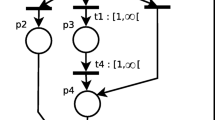Abstract
A stochastic logic network is defined as a connected set of logic and time delay elements. Each of the latter elements has an associated probability distribution describing the nature of that element's delay. When used, for example, in project planning and scheduling, combinations of logic and time delay elements in such networks may represent conditions for the starting of project activities which are themselves represented by time delay elements. It is at present not known how to calculate the probability distributions for the events in such a network. This paper shows how to obtain upper and lower bounds for these probability distributions. The method is not a simulation technique; rather, it is a straightforward computational scheme derived from elementary probability theory. An example is given where the method is applied to a stochastic project scheduling network in which alternative ways exist for carrying out one of the jobs in the network.
Similar content being viewed by others
Author information
Authors and Affiliations
Rights and permissions
About this article
Cite this article
Kleindorfer, G., Kleindorfer, P. Bounding Distributions for Stochastic Logic Networks. J Oper Res Soc 25, 465–479 (1974). https://doi.org/10.1057/jors.1974.80
Published:
Issue Date:
DOI: https://doi.org/10.1057/jors.1974.80




